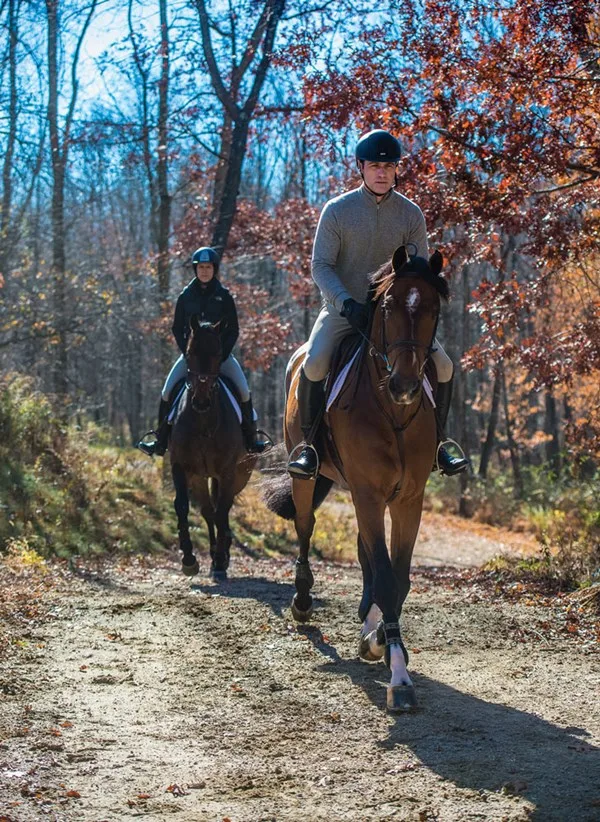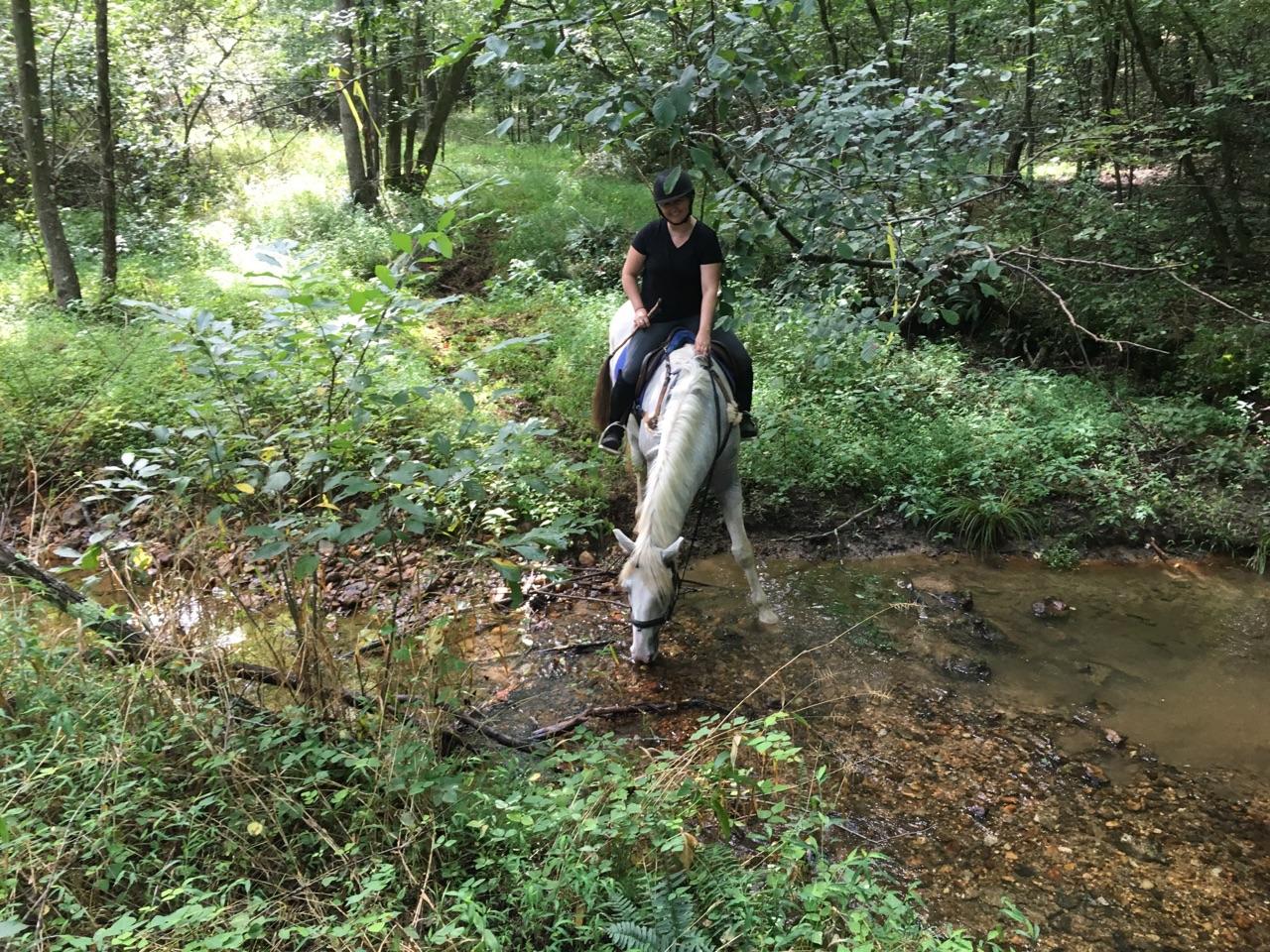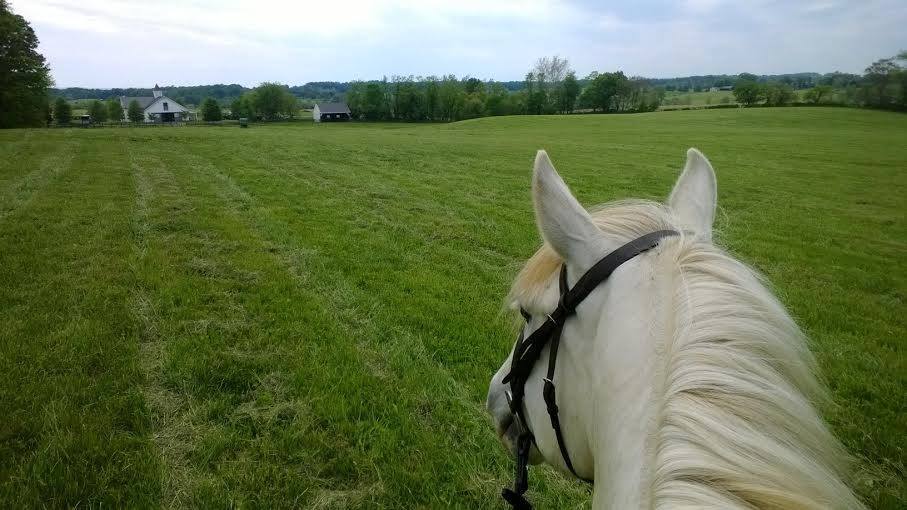
No matter what discipline you enjoy, just about every single one requires a horse to have strength, stamina and a bit of bravery and trust in their partner. And the same can be said for the rider as well. If you’re a dressage, hunter or jumper rider, you might think that most of your work and preparation for shows can be accomplished in the ring, which is the environment in which you’ll be showing. However, that’s not always the case. Five expert horseman share their reasoning behind why it’s advantageous to get outside the ring (and sometimes outside of your comfort zone) to help you and your horse reach your goals in the show ring.
1. Strength Training with Hill Work:
Most rings tend to be flat, and it can be tough to work all the different kinds of muscles in your horse’s body. If you’re lucky enough to be in an area with hills, you can easily give your horse a full-body workout. “Working on an uphill gradient activates the propulsive muscles in your horse’s hind limbs,” says Hilary Clayton, BVMS, PhD, Dipl. ACVSMR, MRCVS, a veterinarian who has done extensive research on the biomechanics of equine locomotion, conditioning programs for equine athletes. Additionally, “Walking slowly downhill with your horse in self-carriage activates the muscles that raise his withers.”
Don’t just dawdle along on a loose rein the whole time, says Dr. Clayton, be productive: “When trail riding, work your horse in a rounded frame so that he uses his core muscles and include some lateral movements, such as leg-yielding, to stretch and supple both sides of his body.”
Grand prix dressage rider JJ Tate agrees, saying, “You can gain a lot of thrust, one of the biggest components of First Level, by walking up and down hills, trotting up hills (avoid doing too much trotting downhill, which loads the front end) and doing forward canters in an open field.”
Additionally, performing on uneven ground requires confidence, which can be gained by experiencing it at home. “Gradually ease into hillwork, first with small hills then slightly steeper ones, to improve both your and your horse’s strength and balance,” advises grand prix show jumper Peter Lutz.
Because hillwork can be tough on horses, especially their joints and muscles, Australian show jumper Lane Clarke warns not to overdo it. “Fitness trail rides that emphasize strong hill and collection work are never done on back-to-back days because the horse’s muscles need time to recover,” he says.

2. Fine-Tune Your Position:
Riding outside the ring is also a great way to polish your own position.
“Because the varying terrain requires you to adjust your weight constantly to stay in balance with the horse, this is an excellent strengthening exercise for riders, too,” says Lutz. “On the hills, you need to stay lighter in your seat, keeping your weight off your horse’s back.”
Dressage riders can also see huge benefits to their position when they leave the ring. “Allow the beauty of the woods to inspire you to sit a little taller in the saddle, even challenging yourself to look up at the tops of the trees to help with your posture,” says Tate. “Concentrate on staying grounded in your seat while processing what your horse is telling you about his balance. Being able to focus on yourself while you are taking in all the exciting outside distractions will also help in the show ring.”
3. Help Avoid Injuries:
“Wear-and-tear injuries, such as bowed tendons and pulled suspensories, are a consequence of stressing the same parts of the body in the same way repeatedly,” says Dr. Clayton. “The risk of wear-and-tear injuries is reduced by varying the type of exercise, by working your horse on different surfaces and terrains and by scheduling easy days in between hard workouts.”
Another thing to consider is the drastic change between two different types of footing. If you’re lucky enough to head south for the winter, keep in mind that your horse may require time adjusting between the two demographics. “In Florida, [the horses] had worked almost exclusively in flat sand rings,” notes Lutz. “They needed time to adjust to the different physical demands and feel of the large, grassy field at Old Salem Farm [in New York] and prepare for its natural obstacles, which include a natural bank, grob (sunken road), ditch and open water.”
Lutz also wants riders to think about the specific competition venue and type of classes you are entering. “Evaluate the size, footing, terrain and visuals of the competition arena. Is it on sand or grass? Indoors or outdoors? What types of jumps will there be? Will there be any new questions that you and/or your horse have never encountered before? If so, it is extremely important that you make the time to introduce yourselves to these new challenges at home beforehand.” This, in turn, will help your horse become more comfortable with the new conditions and footing and help prevent injuries.
“The better prepared you and your horse are, the more confident you will feel and the more mentally and physically fit you will be for the task at hand. Over the long term, properly preparing your horse for every show will also help to keep him happy, healthy and sound—helping to extend his competitive career.” – Peter Lutz

4. Establish Trust:
Trail-riding strengthens your relationship with your horse, making the work in the ring that much better. With consistent, positive training, soon enough barking dogs, flapping flags and other spooky scenarios will be a thing of the past, as your horse looks to you as his partner to help him be confident…both in AND out of the ring.
“Because trail rides often include a few scary situations—at least from the horse’s perspective—teaching your horse that he needs to listen to your aids and trust you as his leader, no matter where you are, can help,” says Clarke. “Both of those behaviors translate to more responsiveness in the arena and a better bond with your horse.”
5. Build Your Horse’s “Fifth Leg:”
Top show jumper Richard Spooner utilizes trail riding, for both his young horses and veterans, for its mental and physical conditioning. “It’s good for them getting used to watching where they are going, to going up and down hills, getting used to putting weight on their hindquarters and to traveling with their body in different balances.”
In addition to watching where they are going, the horses have to engage their muscles’ slow-twitch fibers to help develop endurance and strength and stretch their backs and stifles going up and down the hills. “It really works out the knots both physically and mentally,” he adds.
Clarke agrees, but cautions to take it slow when first introducing a horse to work outside the ring, because “if they’re not used to riding on different terrain, it takes a while for them to gain that agility and their proprioception—their sense of where their feet and the rest of their body parts are in relation to the terrain. When they improve their natural agility, it really helps their ability to adjust to anything that comes up on a tricky course or to recover from a misstep.”











